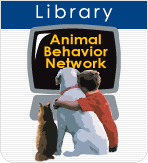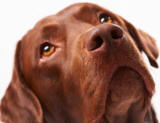|
Need Help?
|
|
Call
1-800-372-3706
to
speak to a Veterinary Behavior Technician |
|
Paws To Speak!
Member
Main Menu
|
|

Destructive
Chewing
Rawhide Chews
Destructive
Chewing - Q&A
Veterinary and Boarding Kennel Tip
Fill Kongs of all sizes with
canned food. Place a tasty
dog treat stick of inside
the kong to create a fuse, and place the Kongs in
the freezer. Provide a comfy towel or washable
fleece inside the kennel for added comfort.
.jpg)
At Home
Provide
non-consumable
chews and a soft cushy pillow in the
dog's kennel to keep kenneling comfortable and positive.
The price is right!
Introduce cold carrots chews to
help
sooth teething discomfort.
|
 |
|
Help is at your
fingertips by library, email and
phone. |

Click on
Library Icon
to learn more
|
Why do dogs chew?
Chewing is a natural, normal behavior for dogs.
Young dogs, similar to babies, explore the world with their mouths.
Young dogs also experience the discomfort of teething. Pups begin to
loose their baby teeth around four months of age. Adult canine teeth
replace the baby teeth over a period of four to six months.
Just like people, some
dogs like to have something in their mouths. Some
dogs simply like to chew. Chewing is one way dogs
release stress. Chewing can be a calming behavior.
The problem with chewing is when dogs are not taught
what they can and cannot chew. It is a mistake to
punish dogs for this natural behavior. Instead, dogs
need to be praised and encouraged to chew the right
things while prevented from chewing the wrong
things.
|
The dog learns to find the
chew and hold it in his or
her mouth to earn attention,
praise and greetings.
|
Chewing
is a form of physical and mental exercise that
strengthens the jawbone by holding the teeth in
place. Dogs can be taught to chew for
enjoyment and to relieve boredom or stress. Positive
chewing is not only a fun, healthy activity for
dogs, it helps reduce dental tartar.
Teach the dog what TO
chew and what NOT to chew.jpg)
It is much
easier to teach a dog what TO chew than it is to
teach him or her what NOT to chew. Teach positive
chewing by making a BIG fuss over the dog that
gives any attention to the right chew. Pretend you
are chewing on it to further interest your dog in
giving this chew a try. Put something extra tasty
like peanut butter on a new chew to get the dog
going and give you the opportunity to praise this
activity.
Teaching your dog the
"get your chew" exercise
Begin the
game, "get your chew" by YOU first getting the chew
and then getting the dog to take it for just a
second. Lavish praise on the dog for THAT second,
then ignore the dog when the chew is dropped.
A few minutes later, repeat this exercise. Soon, the
dog will learn how to earn your
concentrated attention and praise. Eventually, you
want to be able to cue the dog, "get your chew" and
have the dog search the house for it in delight and
anticipation or your greeting. The dog learns to
hold the chew in its mouth to earn attention, praise
and greetings. You may also want to combine
this exercise by teaching the dog to "sit" with the
chew in its mouth when greeting people.
|
Teaching this polite way
to greet people redirects
the excitement of greetings
and helps prevent unwanted
jumping up and mouthing. |
What if my dog does not like to
chew?
For
reluctant chewers, start with a
consumable chew such as a
Milk-Bone® dog biscuit. Then
gradually increase the hardness
of the chew toys being careful
not to give the puppy a chew
that is too hard and could break
his or her baby teeth. Select
items that allow the dog to
succeed in chewing off small
pieces of the material, while at
the same time being careful not
to allow large pieces that could
cause intestinal obstruction to
be consumed.
Chewing safety
Raw
bones should be boiled for
safety reasons, and impossible
for the dog to swallow such as a
"knucklebone" or large beef rib
bone. Allow chewing on bones for
no more than 10 minutes so the
dog can chew on it and exercise
his or her teeth, then "trade
it" for different type of chew
toy. As the dog learns to
chew and stop chewing the bone
on its own, then the bone can be
left with the dog for longer
periods of time. With bones,
there is always the possibility
of either splintering or
swallowing a piece too large, resulting in medical problems.
Extremely hard items such as ice
cubes, nylabones, and raw bones can result in broken teeth, consult
your veterinarian before offering these items to your pet. If you offer rawhides, make sure
they are not small enough to
swallow. Allow chewing
under supervision, then remove
the rawhide and store in a
baggie in the freezer.
Supervision is the key!
Offer non-consumable,
durable brand name chew toys that can be stuffed
with food treats such as Kongs, Busy Bodies, and
Planet Pet Toys.
|